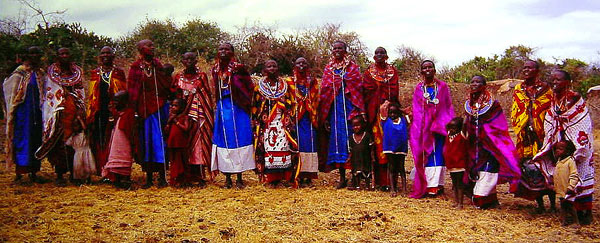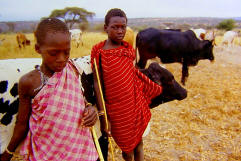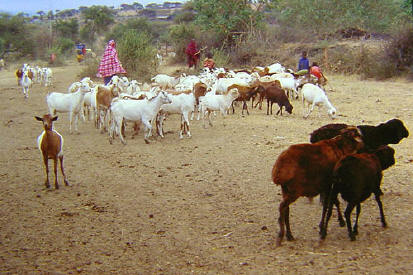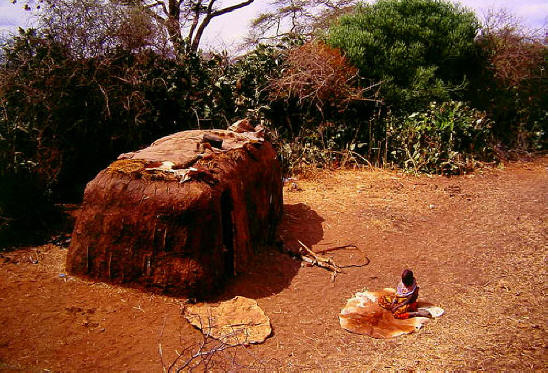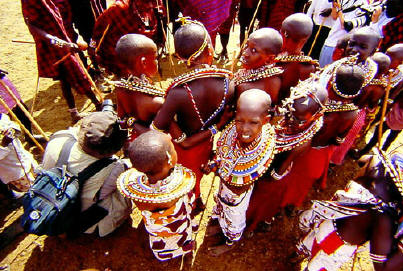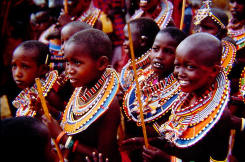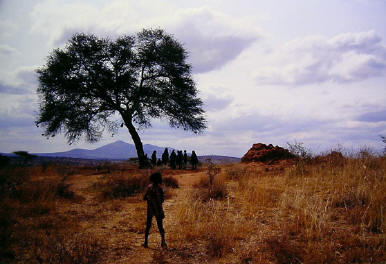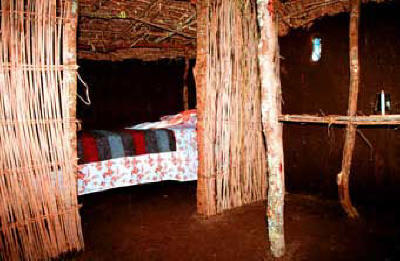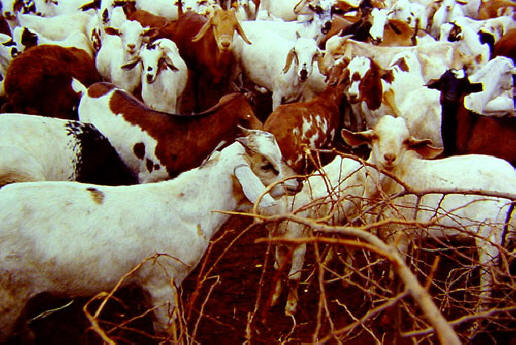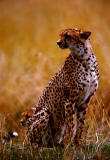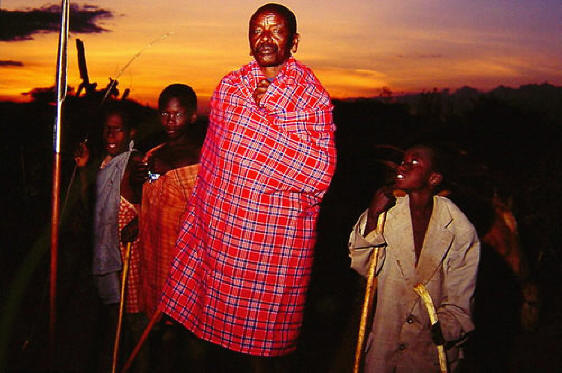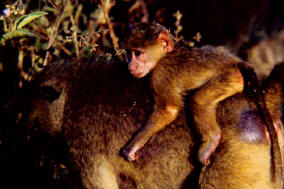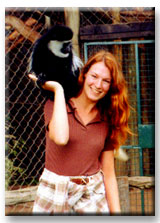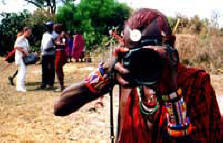|
PHOTOGRAPHING THE ANCIENT MAASAI by Tina Wright The first time I laid eyes on them, I knew I had to capture them on film. They were tall, slender, primordial beings. In a vast sea of wind-swept grasses they stood motionless, two dark forms from some bygone era poised against a foreboding sky. Spears in hand and self-assured, it was apparent they knew their place in a boundless ecosystem of wilderness. Not even the threat of a stalking lion could shatter that air of determined defiance. For thousands of years the plains of Africa had been their home, and they knew they belonged to the land just as surely as the lion did. They belonged to the ancient tribe of the Maasai! Perhaps no other tribe in all of Africa is so well known and so personifies the untamed mystique of the Dark Continent as the Maasai. They are a proud people struggling in today's modern society to hold on to their traditional heritage. Despite the pressures they face many still live in isolation, carrying out the customs passed down through millennia by their ancestors. Unfortunately though, there is no way to hold back the tides of change, and with time extinction will be an inevitable truth. WHO ARE THE MAASAI? The Maasai are a semi-nomadic pastoral people with a population of approximately 300,000, whose territory stretches East Africa's Great Rift Valley from southern Kenya deep into northern Tanzania. Their semi-nomadic ways stem from the necessity to follow the seasons in search of fresh water and grazing land for their livestock. In fact, these animals are so much a part of their culture that they dictate almost every aspect of a Maasai's life. This is because, like money to western society, the number of livestock owned - mostly cattle, goats, donkeys, and more recently camels - is a direct reflection of a family's wealth and therefore their status and rank within the tribe.
Their semi-nomadic ways necessitate simplistic living conditions. Each clan, or family unit, is typically made up of one man, his multiple wives, and their children. They live together in a round, fenced compound known as a boma. Each boma consists of livestock pens and several homes, or manyattas. Rudimentary and small, the manyattas are constructed from gathered logs and plastered with a mixture of mud and dung. Standing only about five feet in height, they are without electricity or running water.
A Maasai woman's life is centered solely around family. She will be married off by her mid-teens, often to a man twice her age. The marriage is arranged through the young woman's parents in exchange for a dowry of livestock and handicrafts. From that point forward the woman's rank in society is marked by the amount of children she has.
A man's life in Maasai society revolves around a series of life passages, which are marked by elaborate ceremonies. These passages include childhood (youth), moranism (warriorhood), elderhood (marriage), and finally head elderhood (old age). Entered into as a pre-teen, moranism is perhaps the most anticipated and exciting stage of a man's life. Marked by circumcision, he will spend the remainder of his teens wandering the bush, gathering the skills needed to support and protect his future family as an elder. After elderhood, the only stage left is that of head elder. To attain this status means he has acquired great wealth, married many wives, fathered numerous children, and now commands the highest mark of respect from all those younger than him.
APPROACHING THE MAASAI Now you may be asking yourself, "how do I go about meeting the Maasai"? There are several approaches you may take to do this. The first is the most cost effective and common way. While on an East African safari, simply relay to your guide your interest in visiting a Maasai village. This can easily be arranged, especially if visiting the Masai Mara Game Reserve. Located just outside the Masai Mara's boundaries are several Maasai bomas that cater to the traveling tourist. For roughly twenty dollars, you are allowed access to the boma and as many photographs as you wish to take. An English-speaking Maasai - usually a moran or an elder - will lead you through the boma and the daily lives of his people. These villages are authentic and the people inhabiting them still live a traditional lifestyle. The money you pay benefits the entire boma. The second approach involves a bit more planning on your part. There are a few tour operators that specialize in leading groups on Maasai-oriented trips. These trips are designed specifically for those travelers who want to live with and learn about the Maasai tribe in-depth through first-hand experiences. Generally, these tours are led by Westerners who have formed a close personal relationship with a particular family clan over the course of many years. An average of one to two weeks is usually spent deep in the heart of Maasailand (the geographical territory of the Maasai) in camping style. Over the course of your stay you will have constant interaction with the Maasai while attending ceremonies, embarking on bushwalks, and joining in traditional daily activities such as herding livestock and bloodletting cattle. This is not your average safari. Diligent research on your part is a must and the monetary cost can be rather high, but the gains, both photographically and personally, far outweigh the negatives and offer an enriching and life-altering experience that few have the privilege of knowing! Lastly, if you are not on a specialized safari and a visit to a boma is not possible, you can always grab a few shots by the roadside along the way. Most safari itineraries in Kenya and all in Tanzania travel through heavily populated Maasai territories. Stops at gas stations and shopping bazaars are common along the way. At every stop you will undoubtedly be swamped with people trying to sell you souvenirs, many of them Maasai in traditional clothing. Most will be happy to pose for you, but be prepared to pay for the privilege. Don't be insulted, as this is their right and usually one dollar is all that will be expected. Please though, be respectful and always ask before taking any photographs of the Maasai. Some still hold on to the belief that a photograph can steal their soul, and therefore will be highly insulted if a camera is pointed in their direction. Also, the young moran, with their long, intricately braided hair and impressive spears, can be very alluring, but never under any circumstances photograph them without permission. These young men are in a very excitable stage of their lives and can become aggressive if provoked. PHOTOGRAPHING THE MAASAI Photography techniques and equipment will vary somewhat depending upon the approach taken to photograph the Maasai. If you choose to add the visit into your existing itinerary, plan on working in harsh lighting conditions as these are usually scheduled between morning and evening game drives. This means you can expect to visit the boma in the middle of the afternoon, so unless weather conditions are overcast, which is highly unlikely, a flash will be key to the overall success of your images. When shooting people, use the flash to fill in unflattering shadows cast by the sun's high angle. This technique is referred to as fill-flash and is done by taking a meter reading of the available light and dialing it into the flash. In other words, if your meter reads the scene at 1/125 second at F/8, set your camera at that reading and dial F/8 into your flash at full power. Just make sure that the subject falls within the distance range prescribed by the flash for that setting. If it doesn' t, simply adjust the shutter speed and aperture accordingly. Also, when opting for the boma visit, time will be limited - usually thirty minutes to an hour - which means you need to be prepared to react quickly. Zoom lenses work well in this situation. I own a 28mm-200mm zoom, and have found it to be the perfect tool for this type of spontaneous shooting. I can easily switch from tight telephoto portraits to wide-angle environmental shots in one quick motion without wasting precious moments fumbling with awkward lens changes. Obviously, if you take a specialized trip you will have plenty of opportunities to photograph the Maasai in ideal lighting conditions, but a flash will still come in handy at times, so carry one along. Again zoom lenses work best here. The point of this type of tour is to cover in detail the culture of an ancient race. Consequently much time will be spent hiking over long distances to reach the more remote bomas and to attend ceremonies. By carrying zoom lenses you greatly reduce unnecessary weight, thereby allowing you greater mobility and the freedom to work unhindered. Your lens or lenses should encompass a focal range of at least 28mm to 200mm as mentioned before. If you own anything wider than 28mm, by all means take it with you. I personally love to use my 17mm to 35mm lens when shooting the Maasai. Their constant interaction with the land and animals surrounding them makes for great environmental portraits, and I find that using a super wide-angle view in conjunction with this type of image produces results that are both dynamic and distinctly unique. The type of imagery you should be striving for will be the same regardless of whether you have an hour to shoot or two weeks. You need to keep in mind that you are in a unique situation that few have the benefit of experiencing. Document as much as possible and strive to capture the essence of these extraordinary people and their singular way of life. This means shooting a broad variety of images. Close in on the face for arresting portraits; back off and include picturesque scenery for a sense of place; capture vivid details of multicolored clothing and intricate jewelry; and focus on homesteads and livestock to seize a way of life. CONCLUSION Photography is a powerful tool, bringing about awareness to those who cannot see for themselves. Perhaps that is why I felt such a driving need that first day on the savanna to document these rare and beautiful people. The Maasai are indeed an amazing race, and there is no denying the seductive spell they cast over all that lock eyes with them. Their story is one of a well-established history rooted in time-honored tradition, but the foundation upon which that history was built is beginning to crumble. For those of us who are fortunate enough to meet with and capture on film the lives of the ancient Maasai, perhaps we can in some small way help to patch their foundation, and in doing so delay this tribe's fated end.
Tina Wright
|
